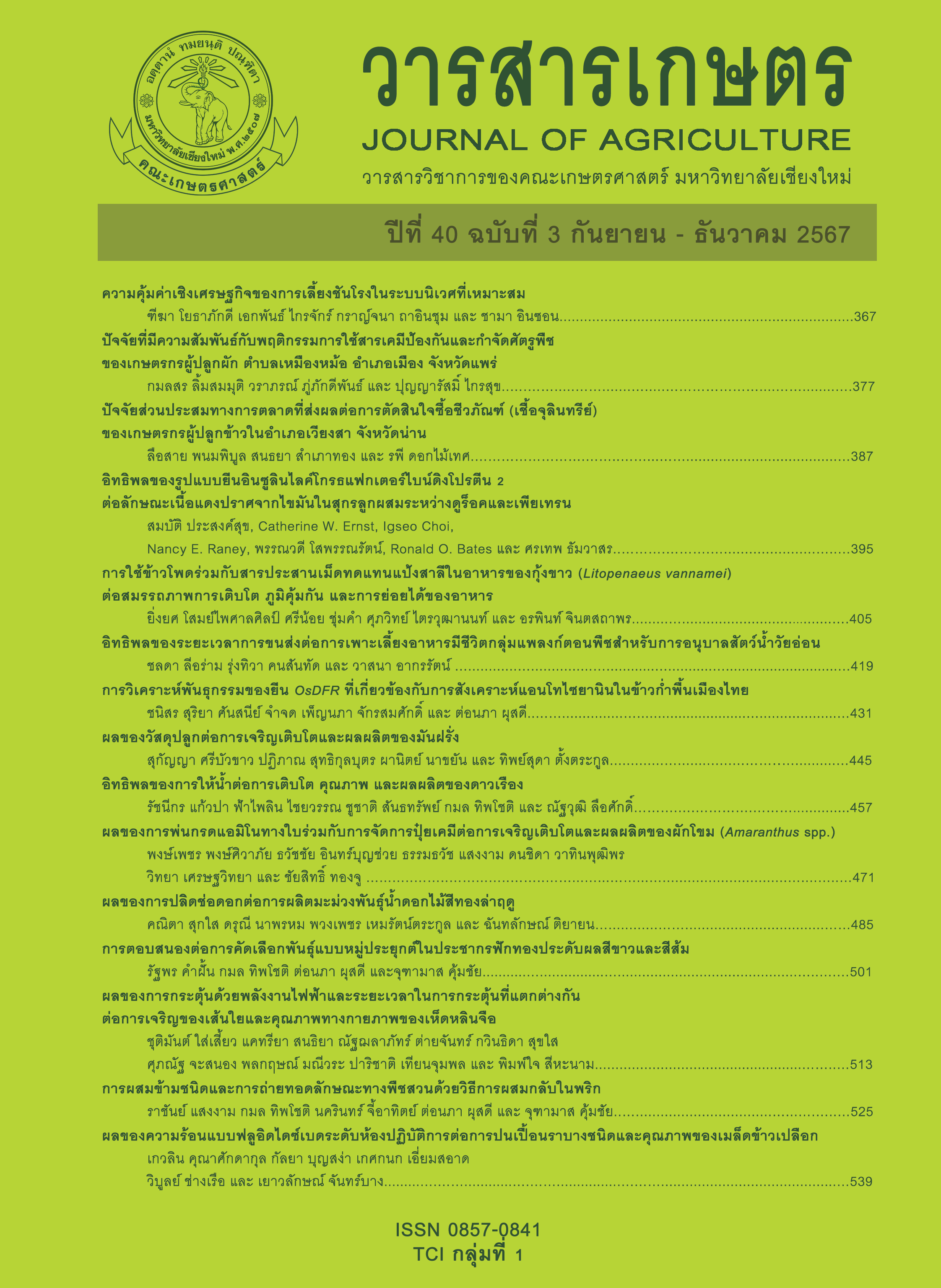อิทธิพลของรูปแบบยีนอินซูลินไลค์โกรธแฟกเตอร์ไบน์ดิงโปรตีน 2 ต่อลักษณะเนื้อแดงปราศจากไขมันในสุกรลูกผสมระหว่างดูร็อคและเพียเทรน
Main Article Content
บทคัดย่อ
อินซูลินไลค์โกรธแฟกเตอร์ไบน์ดิงโปรตีน 2 (ไอยีเอฟบีพี 2) นับว่าเป็นยีนที่มีอิทธิพลต่อลักษณะสำคัญทางเศรษฐกิจในสุกร สำหรับการศึกษานี้ข้อมูลลักษณะเนื้อแดงปราศจากไขมันที่อายุต่าง ๆ จำนวน 11 ลักษณะ ถูกเก็บรวบรวมจากสุกรมีชีวิตจำนวน 408 ตัว โดยเป็นสุกรลูกผสมดูร็อคเจอซี่ x เพียเทรนในรุ่น F2 ลักษณะที่ศึกษาประกอบด้วย ปริมาณเนื้อแดงปราศจากไขมัน เปอร์เซ็นต์เนื้อแดงปราศจากไขมัน ที่อายุ 10, 13, 16, 19 และ 22 สัปดาห์ และอัตราการเพิ่มขึ้นของเนื้อแดงปราศจากไขมันจากอายุ 10 ถึง 22 สัปดาห์ ไอยีเอฟบีพี 2 สามารถจำแนกได้เป็น 3 จีโนไทป์ ได้แก่ AA, AB และ BB โดยเทคนิค PCR-RFLP ใช้เอ็นไซม์ตัดจำเพาะ MspI แบบหุ่นทางสถิติที่ใช้เพื่อศึกษาความสัมพันธ์ระหว่างไอยีเอฟบีพี 2 จีโนไทป์และลักษณะเนื้อแดงปราศจากไขมัน ประกอบด้วยอิทธิพลคงที่ของไอยีเอฟบีพี 2 จีโนไทป์ และเพศ และอิทธิพลสุ่มของกลุ่มการคลอด ครอก คอกขุนภายในกลุ่มการคลอด และค่าคาดเคลื่อนที่เหลือ ผลการศึกษาพบว่าไอยีเอฟบีพี 2 จีโนไทป์มีความสัมพันธ์ (P<0.05) กับลักษณะดังกล่าว โดยสุกรที่มีจีโนไทป์ BB มีลักษณะเนื้อแดงปราศจากไขมันที่อายุ 10, 13 และ 16 สัปดาห์ มากกว่าสุกรที่มีจีโนไทป์ AB ไม่แตกต่างอย่างมีนัยสำคัญทางสถิติ (P>0.05) ที่อายุ 19 และ 22 สัปดาห์ นอกจากนี้ยังพบว่าสุกรมีจีโนไทป์ BB มีเปอร์เซ็นต์เนื้อแดงปราศจากไขมันที่อายุ 13, 16, 19 และ 22 สัปดาห์ ตลอดจนอัตราการเพิ่มขึ้นของเนื้อแดงปราศจากไขมันจาก 10 ถึง 22 สัปดาห์ มากกว่า (P<0.05) ผลจากการศึกษานี้แสดงให้เห็นความสัมพันธ์ของไอยีเอฟบีพี 2 จีโนไทป์กับลักษณะสมรรถภาพการผลิตในสุกรลูกผสมรุ่น F2 และควรมีการศึกษาเพิ่มเติมในสุกรพันธุ์อื่นและสุกรฝูงอื่นเพื่อการนำไปใช้ประโยชน์
Article Details

อนุญาตภายใต้เงื่อนไข Creative Commons Attribution-NonCommercial-NoDerivatives 4.0 International License.
เอกสารอ้างอิง
Baxter, R.C. 2000. Insulin-like growth factor (IGF)-binding proteins: Interactions with IGFs and intrinsic bioactivities. American Journal of Physiology-Endocrinology and Metabolism 278(6): E967-E976.
Chen, P., T.J. Baas, J.W. Mabry, J.C.M. Dekkers and K.J. Koehler. 2002. Genetic parameters and trends for lean growth rate and its components in U.S. Yorkshire, Duroc, Hampshire and Landrace pigs. Journal of Animal Science 80(8): 2062-2070.
Clemmons, D.R. 1998. Role of insulin-like growth factor binding proteins in controlling IGF actions. Molecular and Cellular Endocrinology 140(1-2): 19-24.
Cohick, W.S. 1998. Role of the insulin-like growth factors and their binding proteins in lactation. Journal of Dairy Science 81(6): 1769-1777.
de Lange, C.F.M., B.J. Marty, S. Birkett, P. Morel and B. Szkotnicki. 2001. Application of pig growth models in commercial pork production. Canadian Journal of Animal Science 81(1): 1-8.
Dekkers, J.C.M. and F. Hospital. 2002. The use of molecular genetics in improvement of agricultural populations. Nature Reviews Genetics 3(1): 22-32.
Edwards, D.B., C.W. Ernst, R.J. Tempelman, G.J.M. Rosa, N.E. Raney, M.D. Hoge and R.O. Bates. 2008. Quantitative trait loci mapping in an F2 Duroc × Pietrain resource population: I. Growth traits. Journal of Animal Science 86(2): 241-253.
Hammond, K. and H.W. Leitch. 1998. Genetic resources and the global programme for their management. pp. 405-425. In: M.F. Rothschild and A. Ruvinsky (eds). The Genetics of the Pig. CAB International, Wallingford.
Hayes, B. and M.E. Goddard. 2003. Evaluation of marker assisted selection in pig enterprises. Livestock Production Science 81(2-3): 197-211.
Hoeflich, A., M. Wu, S. Mohan, J. Foll, R. Wanke, T. Froehlich, G.J. Arnold, H. Lahm, H.J. Kolb and E. Wolf. 1999. Overexpression of insulin-like growth factor-binding protein-2 in transgenic mice reduces postnatal body weight gain. Endocrinology 140(12): 5488-5496.
Li, H., N. Deeb, H. Zhou, A.D. Mitchell, C.M. Ashwell and S.J. Lamont. 2003. Chicken quantitative trait loci for growth and body composition associated with transforming growth factor-β genes. Poultry Science 82(3): 347-356.
Li, Z.H., H. Li, H. Zhang, S.Z. Wang, Q.G. Wang and Y.X. Wang. 2006. Identification of a single nucleotide polymorphism of the
insulin-like growth factor binding protein 2 gene and its association with growth and body composition traits in the chicken. Journal of Animal Science 84(11): 2902-2906.
McPhee, C.P., G.A. Rathmell, L.J. Daniels and N.D. Cameron. 1988. Selection in pigs for increased lean growth rate on a time-based feeding scale. Animal Production 47(1): 149-156.
Mote, B.E. and M.F. Rothschild. 2006. SNP detection and linkage mapping for pig genes involved in growth. Animal Genetics 37(3): 295-296.
National Pork Producer Council (NPPC). 2000. Pork Composition & Quality Assessment Procedures. National Pork Producer Council, Des Moines, IA. 50 p.
National Research Council (NRC). 1998. Nutrient Requirements of Swine. 10th ed. National Academies Press, Washington, DC. 211 p.
Pagan, M., J. Cowley, N.E. Raney and C.W. Ernst. 2001. Evidence for an association between a Hind III PCR-RFLP at the bovine insulin-like growth factor binding protein-2 (IGFBP-2) locus and growth and carcass traits in beef cattle. Journal of Animal Science 79 (Suppl.1): 242 (Abstract).
Prasongsook, S., I.S. Choi, R.O. Bates, N.E. Raney, C.W. Ernst and S. Tumwasorn. 2015. Association of Insulin-like growth factor binding protein 2 genotypes with growth, carcass and meat quality traits in pigs. Journal of Animal Science and Technology 57: 31- 41.
Rechler, M.M. 1993. Insulin-like growth factor binding proteins. Vitamins and Hormones 47: 1-114.
Schinckel, A.P. 1994. Nutrient requirements of modern pig genotypes. pp. 133. In: P.C. Garnsworthy and D.J.A. Cole (eds). Recent Advances in Animal Nutrition. Nottingham University Press, Loughborough.
Schinckel, A.P. and C.F.M. de Lange. 1996. Characterization of growth parameters needed as input for growth models. Journal of Animal Science 74(8): 2021-2036.
Schinckel, A.P., P.V. Preckel and M.E. Einstein. 1996. Prediction of daily protein accretion rates of pigs from estimates of fat-free lean gain between 20 and 120 kilograms live weight. Journal of Animal Science 74(3): 498-503.
Schinckel, A.P., J.W. Smith II, M.D. Tokach, S.S. Dritz, M. Einstein, J.L. Nelssen and R.D. Goodband. 2002. Two on-farm data collection methods to determine dynamics of swine compositional growth and estimates of dietary lysine requirements. Journal of Animal Science 80(6): 1419-1432.
Song, S., C.Y. Lee, M.L. Green, C.S. Chung, R.C.M. Simmen and F.A. Simmen. 1996. The unique endometrial expression and genomic organization of the porcine IGFBP-2 gene. Molecular and Cellular Endocrinology 120(2): 193-202.
Statistical Analysis System (SAS). 2003. SAS/STAT User Manual, Version 9.1. Statistical Analysis Institute, Inc., Cary, NC. 136 p.
Wang, W., Q. Meng, X. Hu, J. Fei, J. Feng, W. Liu and N. Li. 2008. Chromosome location and association of haplotypes of insulin-like growth factor binding protein-2 with production performance in swine. Biochemical Genetics 46(7-8): 381-391.


